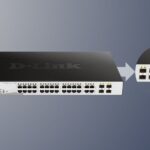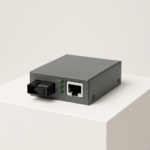
Feb 10 2025
/
SFP vs. SFP+ : How to Choose the Best Transceivers for Your Network

When designing a robust network infrastructure, one decision often overlooked (but highly impactful) is the choice between SFP (Small Form-Factor Pluggable) and SFP+ (Small Form-Factor Pluggable Plus) transceivers. These modules are small devices that enable high-speed data transmission over fiber optic or Ethernet cables, connecting networking equipment like switches and routers. Choosing the right transceivers can directly affect network performance, functionality, and long-term scalability.
This guide will explore the differences between SFP and SFP+ modules, explain their various roles in network infrastructure, and help IT professionals make a well-informed decision based on their specific needs.
What Are SFP Modules?
SFP modules are compact optical transceivers designed for efficiency and versatility in network infrastructure. These devices fit into SFP slots on switches and networking equipment and offer a reliable solution for different fiber optic and Ethernet protocols, including Fast Ethernet and Gigabit Ethernet.
Key features of SFP modules include:
- Data Speeds: Up to 1 Gbps, suitable for small offices or basic enterprise networks.
- Distance: Supports short to medium transmission distances (100m to 100km).
- Compatibility: Works with multiple network protocols, making them a versatile option.
By allowing rapid data exchange, SFP modules play a crucial role in creating flexible and scalable network architectures.
What Are SFP+ Modules?
The SFP+ module is an advanced version of the SFP, offering significantly higher performance for demanding network environments. Designed for data speeds of up to 10 Gbps or higher, SFP+ modules are often found in modern data centers, enterprise networks, and other high-bandwidth applications.
Key features of SFP+ modules include:
- Data Speeds: Up to 10 Gbps, with some models supporting speeds up to 16 or even 32 Gbps.
- Distance: Transmission distances of up to 120km, ideal for long-range communication.
- Energy Efficiency: Consumes less power compared to traditional SFP modules.
- Backward Compatibility: SFP+ modules work in SFP slots but will operate at reduced speeds.
These features make SFP+ modules a preferred choice for applications requiring both scalability and high-speed data performance.
SFP vs. SFP+: Key Differences
Although SFP and SFP+ modules share a similar form factor, they exhibit several differences in capabilities. Here’s a closer comparison:
1. Data Rates and Distances
- SFP: Supports speeds up to 1 Gbps and transmission ranges from 100m to 100km.
- SFP+: Offers data speeds up to 10 Gbps, with extended ranges up to 120km.
2. Power Consumption
- SFP modules generally have higher power consumption than SFP+ modules.
- SFP+ modules are more energy-efficient, reducing operational costs over time.
3. Compatibility
- SFP+ modules offer backward compatibility with SFP slots but will operate at lower speeds when used this way.
- SFP modules cannot take advantage of the higher speeds of SFP+ ports.
4. Applications
- SFP modules are ideal for basic data transmission in small networks, such as enterprises with moderate data exchange needs.
- SFP+ modules are preferred for high-demand scenarios, such as data centers, server rooms, and long-distance connections.
Practical Applications of SFP and SFP+ Modules
SFP Modules
SFP modules are frequently used for:
- Enterprise Networking
- Supporting Fast Ethernet (100 Mbps) and Gigabit Ethernet (1 Gbps) connections.
- Storage Area Networks (SANs)
- Enabling high-speed data backup and clustering functions for reliable data availability.
- Campus Connections
- Offering cost-effective communication over short to medium distances.
SFP+ Modules
SFP+ modules cater to more advanced and bandwidth-intensive use cases:
- Data Centers
- Supporting 10 Gigabit Ethernet (10GbE), which is critical for modern cloud-based IT infrastructures.
- High-Performance Computing (HPC)
- Providing ultra-fast interconnects for compute node communication and data storage.
- Fiber Channel Over Ethernet (FCoE)
- Enabling converged traffic over Ethernet for streamlined infrastructure.
Choosing the Right Transceiver for Your Network
Selecting the right transceiver will depend on your network’s specific requirements, including data speeds, transmission distances, and scalability.
Opt for SFP Modules When:
- Your network has basic data transmission needs, such as small office networks or campus connections.
- Your transmission distances range between 100m to 100km.
- You want an affordable, energy-efficient solution for simple setups.
Opt for SFP+ Modules When:
- Your network demands high-speed data transfer (up to 10 Gbps).
- You’re operating in environments like data centers or have long-distance connections (up to 120km).
- Scalability is essential for future growth.
Comprehensive Considerations:
- Budget: SFP+ modules are more expensive but offer greater performance and scalability in the long run.
- Network Size: Small-scale networks may not require the added capabilities of SFP+ modules.
- Future Growth: Consider the needs of future network upgrades. Opting for SFP+ modules ensures flexibility.
Bringing It All Together
The choice between SFP and SFP+ modules is critical in building a reliable network infrastructure. Small businesses and office networks can benefit from cost-effective and flexible SFP modules, while high-demand environments like data centers will need the advanced performance of SFP+ transceivers.
When making your choice, always consider factors such as network bandwidth, distance requirements, scalability for future growth, and compatibility with existing equipment. By taking a strategic approach to transceiver selection, you can ensure long-term improvements in your network’s efficiency, functionality, and reliability.
For more insights on network optimization or to explore high-quality transceivers, consult industry experts or trusted suppliers to find the best solution for your specific needs.
Frequently Asked Questions
1. What is the difference between SFP and SFP+ transceivers?
SFP (Small Form-factor Pluggable) transceivers are designed for speeds up to 1 Gbps, making them ideal for standard office and small business applications. SFP+ (Enhanced Small Form-factor Pluggable) transceivers, on the other hand, support speeds up to 10 Gbps and are commonly used in high-performance environments like data centers.
2. How do I choose the right transceiver for my network?
To select the right transceiver, consider factors such as required bandwidth, transmission distance, compatibility with existing devices, and future scalability needs. Consult with network professionals if you’re uncertain about the specifications.
3. Are SFP transceivers compatible with all switches?
Not all SFP transceivers are universally compatible. Always check the compatibility of the transceiver with the specific brand and model of your switch or networking device to ensure proper functionality.
4. Can I use SFP+ transceivers in an SFP slot?
While some devices may support backward compatibility, SFP+ transceivers generally require a slot designed for SFP+. Always check the specifications of your hardware to confirm compatibility.
5. What types of cabling do I need for SFP and SFP+ transceivers?
This depends on the transceiver type. For short-range connections, you can use Direct Attach Cables (DAC) or multimode fiber. For long-range applications, single-mode fiber is often required. Always match the cable type with the transceiver’s specifications.





